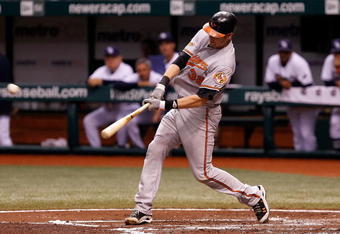Long suffering Oriole fans have had to deal with an inordinate amount of losing over the last decade, brought about by some avoidable (poor management) and unavoidable (being collateral damage in the Yankee-Red Sox 100 years war) circumstances.
After a failed early decade spending spree, the Orioles brain trust finally determined the only way to compete effectively in the AL East was to build through the minors, and with that came 2007 first-round pickMatt Wieters. Now while it is true, Wieters once framed a pitch so perfectly it counted as two strikes (it's a Matt Wieters Fact, and everything on the Internet is true) his sublime greatness has yet to translate to solid production at the major league level. Wieters is still young (he'll turn 25 in May) so it's not time to hit the panic button, but there are some red flags, especially in terms of power and selectivity.
First, the power outage. Wieters' ISO score has dropped consistently since Double-A, from an impressive .260 to .128 in 2010, putting him just above Kurt Suzuki (.123) and just below Joe Mauer (.141) among major league catchers with at least 400 plate appearances. The presence of Mauer here is deceptive; although he had a big power year in 2009, his 2010 score was more in line with career averages, as Mauer is known more for being a great hitter than a great power hitter. Wieters' reputation throughout college and the minors was that of a power hitter, so the low ISO scores over 887 major league plate appearances are cause for alarm.
The second big problem here is the K/BB ratio. A high K percentage isn't an anomaly among power hitters, and if Wieters were in fact hitting for power, no one would care that he strikes out over 20 percent of the time. The problem is he isn't. Of qualifying catchers (as I've determined qualifying, over 400 PA) Wieters is sixth highest in K percentage (21.1 percent) but 11th in ISO—no other catcher who struck out over 20 percent of the time had an ISO below .158.
 J. Meric/Getty Images
J. Meric/Getty ImagesCompounding the strikeout problem is the walk rate: 9.4 percent in 2010, good for sixth among qualifying catchers, but not good enough to make up for the strikeouts. As a result, Wieters sported a 0.50 BB/K ratio, good for 12th best in the league, and his unusually low batting average in 2010 dropped his on-base percentage to .319.
Overall, it's easy to just say Wieters had a down year, but eventually the hype won't mask the performance. Until the manReggie Jackson refers to as "Mr. Whenever the Hell He Wants" proves he can do what he did in Double-A at the major league level, the questions will remain. I'm still bullish on Wieters for now, but another season of being out-slugged by Ryan Doumit will bring an end to that.
The saving grace for O's fans may be that all of Baltimore's top-level prospects seemed to have underperformed for their expectations, so perhaps the problem had to do with the pre-Buck Showalter regime. Whatever the case may be, 2011 is fixing to be a big year in Baltimore.